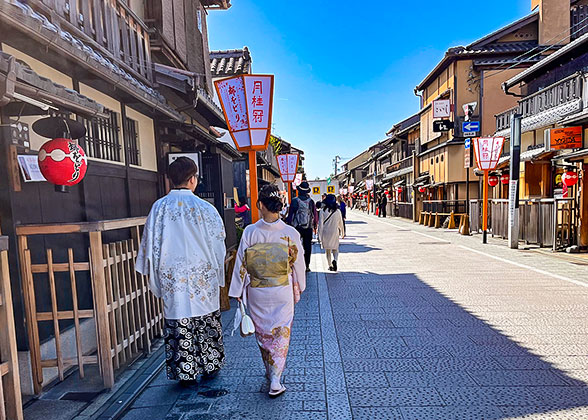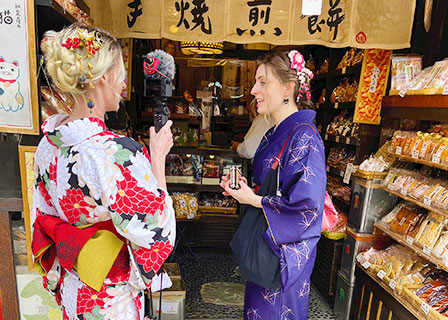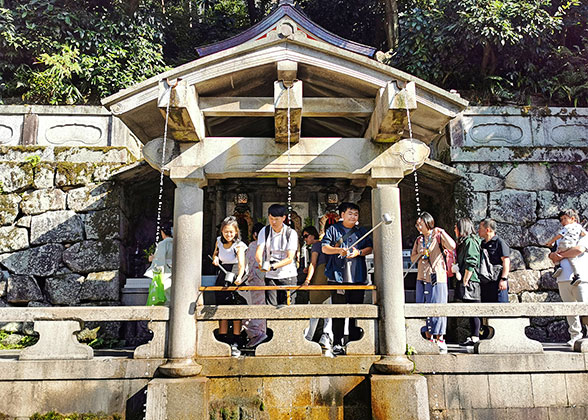Gion District

Gion District Photos ( 29
|
Historical Facts
![]() Gion district is situated before and derives its name from the eastern Gion Shrine, commonly known as Yasaka Shrine. As such, it’s also associated with the Gion Festival, one of the biggest festivals in Japan and held in the shrine in July.
Gion district is situated before and derives its name from the eastern Gion Shrine, commonly known as Yasaka Shrine. As such, it’s also associated with the Gion Festival, one of the biggest festivals in Japan and held in the shrine in July.
![]() For the surviving Edo-era buildings, Gion was designated in 1999 as an Important Preservation District of Historic Buildings.
For the surviving Edo-era buildings, Gion was designated in 1999 as an Important Preservation District of Historic Buildings.

Two girls wearing Kimono in Gion District
|
Must-sees at Gion District
Machiya, old townhouses flanking the Gion streets
Dominating the sides of Gion streets are wooden machiya that adjoin each other, which were residences and offices of wealthy merchants built since the Edo period. 5 to 6 meters (16 to 20 feet) wide at the front, machiya appear to be small, but they can actually stretch as deep as 20 meters (66 feet). Now, they’ve changed to cafes, art studios, or shops selling cadies, crafts, kimono, etc.
|
|
|
Hanami-koji Street, the place to encounter Geisha
Hanami-koji Street is the No.1 place of entire Japan to encounter geiko and maiko. It’s a branch of the east-west Shijo Avenue and leads to the southern Kennin-ji Temple. There are many converted machiya houses as classy restaurants, in which kaiseki ryori – a local cuisine – and other haute dishes are served. But what make the street especially famous are ochaya teahouses, the workplaces of those white-faced, red-lipped female artists, who put on kimono and come here to entertain special guests with conversation, tea ceremony and other art performances.
See also:
Where to best experience Geisha Culture?
|
|
|
![]() Be a geiko yourself, by wearing kimono and wig rented from a kimono shop. It can be a memory of a lifetime to stroll Gion in geiko attire.
Be a geiko yourself, by wearing kimono and wig rented from a kimono shop. It can be a memory of a lifetime to stroll Gion in geiko attire.
![]() See Also: Geisha's Performances & 10 Interesting Facts about Geisha
See Also: Geisha's Performances & 10 Interesting Facts about Geisha

Gion and its machiya houses during daytime
|
Shirakawa area, by a river with quiet atmosphere
To the north of the Shijo Avenue flows the Shirakawa River. A distance away from the central commercial area of Gion, the willow-lined riverside enjoys a serene atmosphere that the lively Hanami-koji Street lacks. There are also many classic teahouses and cafes, some of which provide views of the river. It’s a good place to relax.
Pontocho area, where to experience Gion nightlife
Pontocho is a 500-meter-long (0.3-mile-long) lane along the western side of the Kamo-gawa River. Life here particularly happens at night, as it’s the gathering place of bars. During summer, shopkeepers would set up yuka decks or cooling platforms by the river for guests to eat and drink under the starry sky.
Know Before Going
As mentioned above, many tourists come here to spot geisha walking the Gion streets. It’s no problem to shoot a few photos at a polite distance if you encounter some, but please show respect by not disturbing them with stalking.How to Get There?
By bus:Take No.206 from Kyoto Station and get off Gion bus stop.
By train:
Take Keihan Line and get off at Gion-Shijo Station;
Or take Hankyu Line, get off at Kyoto-Kawaramachi Station, and reach Gion by walking towards the Kamo-gawa River.
Nearby Must-See Attractions
The Higashiyama District in which Gion sits boasts many most historic sites of Kyoto. For travelers visiting Gion, you might want to enrich your tour by adding some surrounding attractions to your itinerary:
![]() Kiyodemize-dera Temple (1.3 km/0.8 mi away to the southeast, 17 min’s walk)
Kiyodemize-dera Temple (1.3 km/0.8 mi away to the southeast, 17 min’s walk)
Aka Pure Water Temple, Kiyodemize-dera Temple is a UNESCO-listed and perhaps Kyoto’s most-loved Buddhist temple established 1,200 years ago, with a fascinating waterfall whose “pure” water can be drank for prayer. The main hall has a raised platform, popular for offering a panorama view of the city and surrounding season colors.
![]() Sannenzaka and Ninenzaka (0.9 km/0.6 mi away to the south, 14 min’s walk)
Sannenzaka and Ninenzaka (0.9 km/0.6 mi away to the south, 14 min’s walk)
Sannenzaka and Ninenzaka are sloping shopping streets lying between Gion and Kiyodemize-dera Temple, with an original ancient ambience achieved by hidden poles and wires.
![]() Yasaka Shrine (on the eastern border of Gion)
Yasaka Shrine (on the eastern border of Gion)
Yasaka Shrine is a Shinto religious complex holding the most celebrated Gion Festival, which Gion derived its name from. Gion Festival is held throughout the month of July, to appease raging spirits and purge the city of negative spiritual energy.
![]() Kennin-ji Temple (at the southern end of Gion’s Hanami-koji Street)
Kennin-ji Temple (at the southern end of Gion’s Hanami-koji Street)
Kennin-ji Temple is Kyoto’s oldest Zen temple, a hidden gem for having a break amid the busy Gion area. Typical Zen gardens and awe-inspiring traditional paintings can be founded here.
![]() Nishiki Market (1.1 km/0.7 mi away, 16 min’s walk, across the Kamo-gawa River in the west)
Nishiki Market (1.1 km/0.7 mi away, 16 min’s walk, across the Kamo-gawa River in the west)
Packed with street food stands with many offering free samples, Nishiki is the best place to experience local food culture.
Gion District Photos & Gion Video




